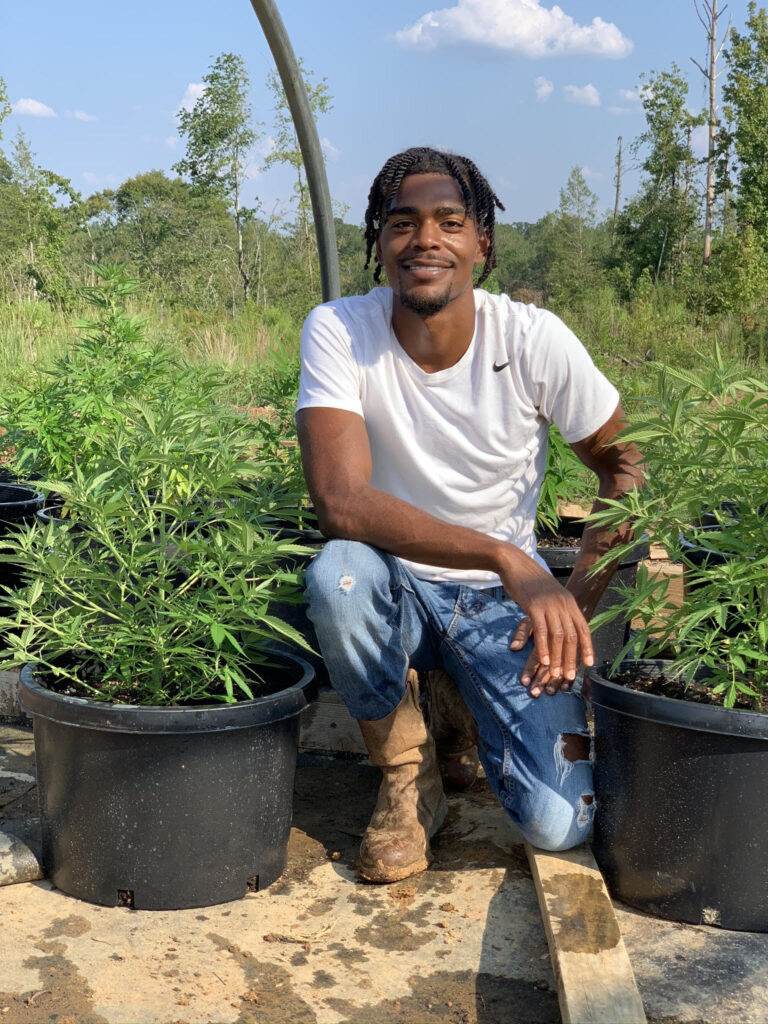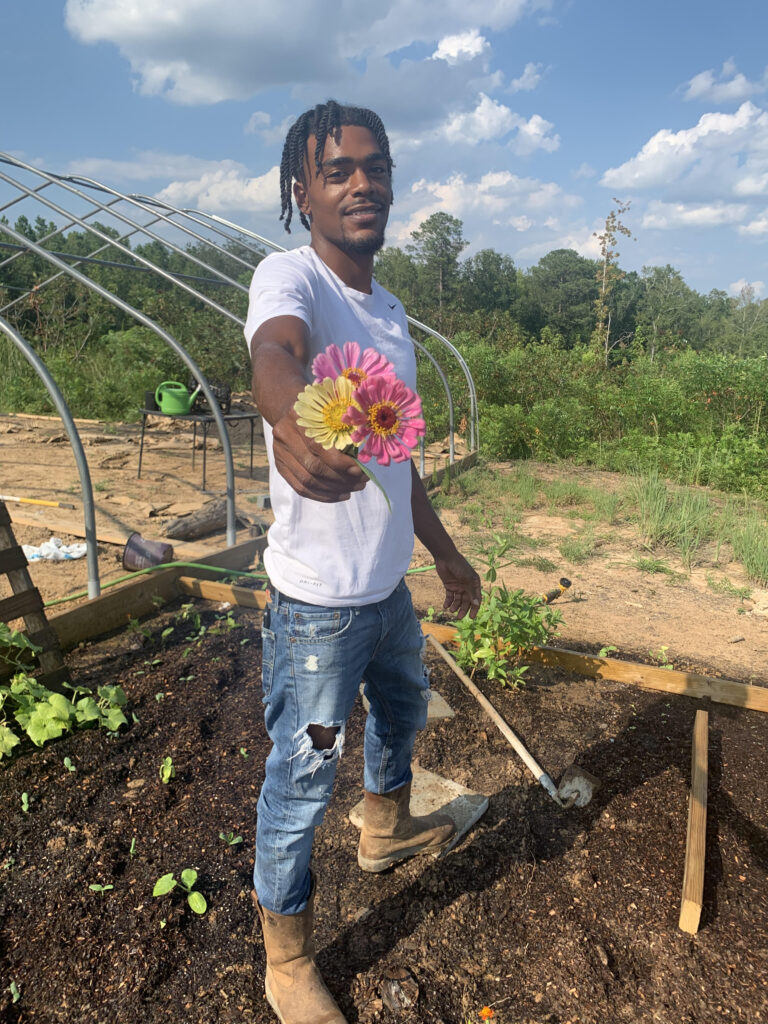Ella Bea’s is in its first year of operation, producing organic blueberries, sweet potatoes, collards, beans, other greens and veggies as well as herbs and hemp. The farm occupies more than 150 acres in Alabama where, in 1884, Asaud’s great-great-uncle Ottaway Bridges inherited property from his father. Ottaway purchased additional nearby land, building up to the 160 acres Asaud stewards today.
Even inheriting family land hasn’t been a walk in the park for Asaud and his operation, though. When Asaud’s great-great-uncle passed the land down to his three sons, the deed fell into heirs’ property, leaving it vulnerable to speculators down the road. All three sons worked the land and eventually passed their portions down to their children. Over time, Ottaway built up his share to more than 150 acres, of which Asaud farms a portion of today.
Heir’s property land ownership

Heirs’ property refers to the condition of land ownership in which property is passed between generations without clear title, often due to the absence of a formal will. There are a number of factors that can result in landowners not creating a will, including mistrust of formal estate planning resources due to a history of abuse and discrimination; lack of access or financial means to obtain legal services and other resources needed for complex estates planning; and cultural values that prioritize verbal, communal transfer of property.
Without a clear designation of heirs, the state becomes responsible for determining legal ownership of the land at the time of transfer, resulting in land owned “in common” by all the heirs, regardless of whether they live, work, or pay taxes on the land. Heirs’ property land ownership has disproportionately affected African-American communities, but also impacts rural Appalachian and Hispanic farming communities, among others. Similar challenges of divided ownership, called fractionated land, exist in Indigenous communities as well but are born from different legal, political, and social legacies.
Because property rights are split between many individuals, heirs’ property issues can prevent farmers from accessing loans, grants, and government assistance, as well as complicate infrastructure investments or land management decisions. In addition, heirs’ property can make a parcel less marketable for sale or lease, and a single landowner can force a sale of the property. This scenario often results in land being sold for much less than market value, property being broken up into parcels that are too small to be efficient for agricultural use, and/or wealthy buyers acquiring land by taking advantage of the vulnerabilities of farmers affected by heirs’ property ownership.
Two Namesakes
Ella Bea’s Farm is named after Asaud’s grandmother, Ella Mae Frazier, and his great aunt Beatrice Jared. Beatrice was a part of the last generation born on the family land. Asaud grew up in Ohio and his aunt Bea would come to visit during the holidays every year from Detroit. He decided to return to the land and begin farming there with the inspiration of his aunt.
Due to heirs’ property land transfer, the land where Ella Bea’s Farm is located is now collectively owned by three generations of Ottaway’s descendants and is extremely vulnerable to attempted sales by speculators. Keeping control and ownership of the family farmland has been a challenge.
Keeping the land
After several generations of vacant ownership, Asaud’s family has faced nearly two decades of court battles with speculators trying to force the sale of the land. “When you have that much land and you’re not there, you become a target for people who are locally aware that there are absentee landowners,” says Asaud. With the land where Ella Bea’s sits divided among many owners over multiple generations, the family was vulnerable to speculators.
That is just what happened in the 1990s when a man bought out one heir of the family land and tried to force a sale. For property divided amongst many owners, this is completely legal. Asaud’s family was ultimately saved by his great-great-uncle’s resourcefulness and the buyer’s greed. When the man forcing the sale came forward, he claimed more shares to the property than he had legally bought using false paperwork. Ottaway Bridges had been decades ahead of his time, though, and back in 1926 had his share of the inheritance surveyed, keeping a copy of that record.

“Alabama is like the wild wild west,” Asaud remarks. It’s not uncommon for speculators to burn down court records and eliminate any publicly held proof of family ownership and inheritance deeds. The courthouse that holds the records for Anne Manie was burned in the 1930s. Fortunately, Ottaway’s daughter had kept copies of the deed dating back to 1926, and when the man came for Asaud’s family land in the late 1990s, Asaud’s father, Andre Frazier, was able to provide the overriding, older deed to prove that the man was using false paperwork with more “bought out shares” than the heir he bought them from had ever been deeded.
After nearly two decades of fighting this theft and the passage of the speculator, Asaud’s family was fortunate to strike a deal with the daughter of the man who had forced the sale. Claiming she was unaware that her father had stolen the land in her possession, she agreed to return the land to Asaud’s family’s ownership. The settlement also required her to pay for the legal fees to draw up a new deed reflecting this change.
But the fight for clear and secure ownership of their family land did not end there. Despite the court order to draw up a new deed, the daughter of the speculator never followed through, leaving Asaud and his father on their own to search for a lawyer who would write a sound deed. It was a struggle to find a lawyer who didn’t predominantly serve speculators, or who didn’t have ties directly to the family who attempted the theft of the land where Ella Bea’s sits, but Asaud and Andre finally found a lawyer who would write the deed for them.
The added costs of startup
Even with Ottaway’s resourcefulness almost a hundred years ago, the family is still covering nearly $100,000 in buybacks for land that was always rightfully theirs, as well as thousands of dollars in legal fees for the civil case and to draw up the new deed themselves—despite the court order for the speculator’s family to cover these costs.
With a new deed drawn and Ella Bea’s in operation now, Asaud is there to keep an eye on the land that has been in his family for four generations. He still thinks about everything his family has gone through, and can’t help but worry sometimes that speculators might “come out of the woodwork” or other challenges to land security might come up.
Addressing heirs’ property
A number of organizations are leading the work to address the challenges farmers face as a result of heirs’ property, including the Land Loss Prevention Project, The Center for Heirs Property Retention, Rural Coalition, the Federation of Southern Cooperatives/Land Assistance Fund, and the Heirs’ Property Retention Coalition.
As a result of their efforts, changes passed in the 2018 farm bill made strides towards helping farmers work through heirs’ property issues by mandating targeted funds, increased outreach, and the reduction of barriers to program participation. Farmers can now obtain a farm number using alternative documentation, and the farm bill also created authority for a new revolving loan fund within the Farm Service Agency to help farmers resolve heirs’ property issues and disputes.
At the state level, the Uniform Partition Heirs Property Act is model legislation proposed and supported by a diverse coalition of organizations across the country that states should consider adopting to provide basic due process protections, including adequate notice, appraisal, and right of first refusal. This law has been enacted in seventeen states, including Alabama, and introduced in eight more.
You can read more about Asaud’s land story and some of the other challenges Black farmers face by checking out this Eater article written by Nadra Nittle.
Photos courtesy of Asaud Frazier
